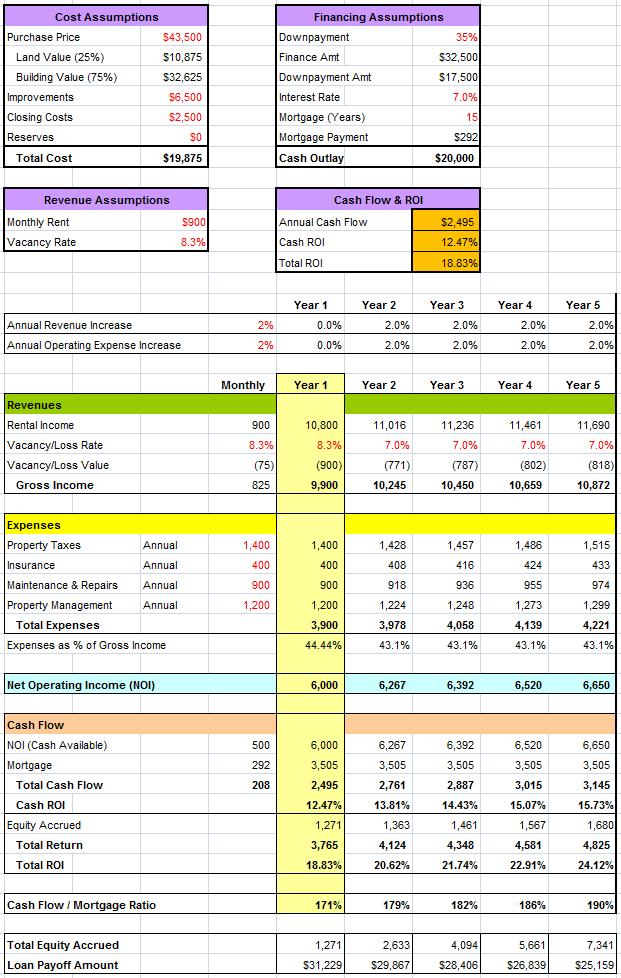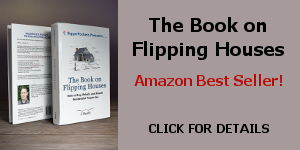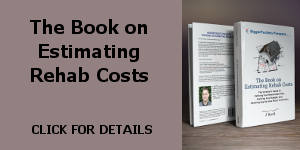As it appears The Haggle House may be our first long-term rental, and given the questions a couple readers have posed, I wanted to spend this post going through the financial details of this particular rental opportunity…
(Note: If you only care about the numbers, feel free to scroll down to the spreadsheet further down this post.)
First, let me review the financial details of the purchase and rehab of this project (for a full tutorial on financial analysis, check out this article):
- Purchase Price: $43,500
- Closing Costs: $2,000 (only incurred at time of refinance)
- Rehab Costs: $6,500
- Financing: 65% LTV, 7.0% Interest, 15 Year Amortization, 3 Year Balloon
The total cost of the purchase and rehab will be $50,000, and once the rehab is complete, I will do a refinance with the terms above. I will refinance 65% of the $50,000 investment, to take a total cash-out of $32,500. My remaining out-of-pocket investment will be $17,500, with another $2,500 in closing costs.
So, my total out-of-pocket cash investment will be right about $20,000.
My monthly income and expenses should break down as follows:
- Income / Rental Rate: $900/month (estimated)
- Vacancy: 8.3% (1 month per year)
- Property Taxes: $1400/year ($116/month)
- Insurance: $400/year ($33/month)
- Maintenance: $900/year ($75/month)
- Property Management: $1200/year ($100/month)
- Mortgage Payments: $292/month
A couple notes about the items above:
- $900/month in rental income is estimated. Realistically, it could be anywhere from $850-950, or even up to $1050 if I rented to Section 8 tenants.
- I haven’t budgeted for capital expenditures (like new roof, new HVAC, new water heater, etc) because the house is only 6 years old, and because I don’t plan to hold it for more than 3-5 years. So, no capital expenditures should be required before I sell.
- We will be doing property management in-house. I will be paying $100/month for one of my employees to manage the property.
- I’ve talked previously about the 50% Rule — that on average, a good rule of thumb is that total expenses plus vacancy will be around 50% of income. In this case, expenses are about 44% of income, which given that our capital expenditures should be low, given it’s a relatively new property and given that we’re doing our own property management, seems about right.
Based on the numbers above, our analysis breaks down as follows:

Ultimately, we’ll see cash flow of about $200/month, our cash-on-cash return will be somewhere around 12.5% and our total return will be about 19%.
While these numbers are decent, they’re not spectacular. But, I believe the real potential of this property is in the short-term appreciation. Because this property is located near last year’s major flooding (estimated at a 1 in 500 year flood), there is a stigma associated with the area and it’s difficult to find buyers interested in the location. But, I think that will change once the memory of the flooding fades and people are more willing to purchase in this part of the city.
After rehab, I have a feeling ARV will be somewhere in the $75K range; but in 3-5 years, ARV could potentially be closer to $120K. Of course, if we don’t see the appreciation we’re hoping for, the property still cash-flows nicely, and we’ll still be making money holding it as a rental.




J…So with the 3 year balloon you will either have to pay the loan in full or refinance in 3 years for another $2500 closing cost? Forgive my ignorance please, still trying to get the hang of the process.
Hey Josh –
That’s a great question! Yes, after 3 years I will either have to pay off the loan or come to an agreement with my lender/bank to extend the existing loan. In general, their policy is to extend the loan for a small fee (about 4% of the remaining loan balance), which would likely come to about $1500 on this property…
[…] How To: Analyze A Good Rental Opportunity Posted by: ed | Category: Flipping Houses, Real Estate Investing, Rehabbing Houses […]
Your numbers look good. I do think your fee for management is a bit high and your expected maintenance a bit low, but overall the numbers look good. $200/mo cashflow is pretty decent. I know your well aware of the fixup prior to sale as well. I honestly think this would be a good rental for you based on the criteria set forth.
Jason
Ditto on Bilgefisher’s comments.
Hey J,
What are the formulas for determining the amount of equity in a house that you are using in the spreadsheet example as well as Cash Flow / Mortgage Ratio?
Great work and it’s great to see how using hard numbers can provide factual data of what is expected.
Thanks!
Hey Scott,
Who do you do your financing with? I’m sorry I’m new to the whole financing scene, but did you take out a mortgage prior to purchasing the property for $50,000 and then refi the property?
Hey Ben –
I purchased this one with my own cash, and then used more of my own cash to do the rehab. Now that it’s rehabbed and rented, I’m planning to do a refi later this week to pull out about 70% of my investment.
I get my financing from a small, local bank here in the Atlanta area…
How exactly does that work, to pull out money by refinancing?
Hi Skye,
Basically, if you own your property outright (no mortgage) or if your property is worth a lot more than what you owe on it (if you have a mortgage), the bank will lend you money against the value of the property. This is no different than getting a loan before you buy the property, except that you’re getting it after you already own the property. Instead of of the bank giving the loan money to the person you’re buying it from, they give it to you, and they get the house as collateral, just like a regular loan.
Does that make sense?
Thanks, I understand now. This blog is amazing! Thanks for sharing and being an inspiration!!!
Thanks Skye!
And just to give an example for anyone who might have read my previous answer and did understand it…
Let’s say you want to buy a house that’s worth $100,000. If you qualify for a loan, the bank will likely be willing to loan you 80% of the value, or about $80,000, to buy the property. You would have to come up with the other 20% ($20,000) yourself.
But, let’s say you buy that $100,000 house with cash (so you own it with no mortgage), and then you decide you want to get some of that money out of the house. The bank is likely still going to be willing to loan you 80% of the value in return for getting the house as collateral, so they’ll be happy to give you $80,000. They have essentially given you back some of your money, and now you’re in the same position as above where you borrowed the money before you bought the house (you still have $20,000 invested, you have a loan for $80,000 and the bank has the house as collateral).